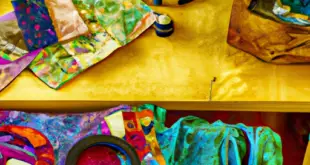Textiles have long been a medium for artistic expression and creative innovation. From ancient civilizations to modern times, people have used various techniques to adorn fabrics with unique and one-of-a-kind designs.
In today’s world, DIY screen printing and block printing methods have become popular ways to create personalized textiles that reflect individual style and creativity.
Screen printing, also known as silk screening, is a printing technique that involves using a mesh screen to transfer ink onto a fabric. This method allows for precise and detailed designs to be replicated onto textiles, making it a favorite among artists and crafters alike.
Block printing, on the other hand, involves carving a design onto a block of wood or other materials and then using that block to stamp the pattern onto fabric. This method offers a more hands-on and organic approach to textile printing, allowing for a more rustic and textured look.
Both screen printing and block printing provide endless possibilities for creating unique and innovative textiles that stand out from the crowd.
Whether you’re a seasoned artist or a beginner looking to explore the world of textile printing, this article will guide you through the process of DIY screen printing and block printing.
We will delve into the various techniques and materials used in these methods, providing you with the knowledge and skills to create your own one-of-a-kind textiles.
From choosing the right materials to mastering the art of printing, we will equip you with the tools and techniques needed to unleash your creativity and bring your innovative textile designs to life.
So, get ready to embark on a journey of artistic exploration and discover the endless possibilities of DIY screen printing and block printing methods.
Exploring Screen Printing Techniques
Screen printing techniques can be explored to create unique and captivating textiles that showcase intricate patterns and vibrant colors.
With screen printing, a stencil is used to transfer ink onto fabric, resulting in a crisp and detailed design. This method allows for precise control over the placement and intensity of the ink, making it ideal for creating intricate patterns and vibrant colors.
By experimenting with different types of screens, inks, and techniques, artists and designers can achieve endless possibilities in their textile creations.
One popular screen printing technique is the use of multiple layers of colors to create depth and dimension in the design. This involves creating separate stencils for each color and carefully aligning them to create a cohesive image.
By printing each color separately, artists can achieve a layered effect that adds visual interest to the textile. Additionally, artists can play with different types of screens, such as fine mesh screens for intricate details or larger screens for bolder designs.
This allows for versatility and creativity in the printing process, resulting in textiles that are visually captivating and innovative.
Choosing the Right Materials for Screen Printing
When selecting materials for the process of printing designs onto fabric, careful consideration must be given to ensure optimal results. The choice of materials plays a crucial role in determining the quality and longevity of the printed design.
The two main components required for screen printing are the screen and the ink. The screen is typically made of a fine mesh stretched tightly over a frame, and the material used for the mesh can vary depending on the desired outcome. For detailed designs or fine lines, a mesh with a higher thread count is recommended to ensure sharpness and precision. On the other hand, for larger, bolder designs, a lower thread count may be more suitable to allow for greater ink flow.
Additionally, the frame itself should be made of a sturdy material, such as aluminum or wood, to provide stability and prevent warping during the printing process.
In terms of ink, there are different types available, including water-based, plastisol, and discharge inks. Water-based inks are known for their eco-friendly properties and provide a soft, breathable finish on the fabric. Plastisol inks, on the other hand, are more durable and offer vibrant colors that remain intact even after multiple washes. Discharge inks, which remove the dye from the fabric and replace it with a new color, are often used for achieving a vintage or worn-out look.
The choice of ink depends on factors such as the desired effect, fabric type, and intended use of the printed fabric. It is important to select inks that are compatible with the chosen fabric to ensure proper adhesion and longevity of the print.
By carefully considering the materials used in screen printing, one can create unique and innovative designs that capture the attention of an audience seeking creative and expressive textiles.
Mastering the Art of Block Printing
Block printing, a traditional technique with a rich history, allows artists to create visually captivating and emotionally evocative designs on various surfaces. This method involves carving a design onto a block of material, such as wood or linoleum, and then applying ink to the raised surface before pressing it onto the desired surface.
The result is a unique and distinctive print that captures the artist’s creativity and imagination. Block printing offers endless possibilities for experimentation and innovation, as artists can explore different carving techniques, ink colors, and surface materials to achieve the desired effect. Whether it’s creating intricate patterns, bold geometric shapes, or organic motifs, block printing allows artists to transform ordinary objects into works of art.
Mastering the art of block printing requires patience, precision, and a keen eye for detail. Artists must carefully plan their designs, considering the composition, balance, and scale of the print. The carving process demands skill and practice, as each mark made on the block will ultimately determine the final outcome.
Artists must also choose the right type of ink for their project, considering factors such as color intensity, drying time, and permanence. Additionally, the choice of surface material plays a crucial role in the success of a block print. Different materials absorb ink differently, resulting in variations in color saturation and texture.
By experimenting with different materials and techniques, artists can push the boundaries of block printing, creating innovative and captivating designs that challenge traditional notions of art and design.
Tips and Tricks for Successful DIY Textile Printing
Achieving successful textile prints involves employing various techniques, such as careful design planning, precise execution, and thoughtful consideration of ink colors and surface materials.
Design planning is a critical step in the process, as it allows the artist to envision the final outcome and make necessary adjustments before printing. This involves selecting the right design elements, such as motifs, patterns, and typography, and arranging them in a visually pleasing and balanced composition. Additionally, the artist must consider the size and scale of the design in relation to the textile, ensuring that it fits appropriately and creates the desired impact.
Precise execution is essential for achieving clean and well-defined prints. This involves properly preparing the printing surface, whether it be a screen or a block, by cleaning and ensuring it is free from any debris or imperfections. The artist should also pay attention to the pressure applied during printing, ensuring a consistent and even application of ink.
Moreover, the use of high-quality inks is crucial for vibrant and long-lasting prints. Artists should consider the compatibility of the ink with the surface material, as well as its opacity and drying time. Experimenting with different ink colors can also enhance the visual appeal of the prints, allowing for unique and innovative designs.
By carefully considering these factors and utilizing techniques with precision, artists can achieve successful and impressive DIY textile prints.
Conclusion
In conclusion, screen printing and block printing are two unique methods that can be used to create one-of-a-kind textiles. By exploring different screen printing techniques, such as stencil and photo emulsion, artists and designers can achieve stunning results. It is important to choose the right materials for screen printing, including the type of screen, ink, and fabric, in order to ensure a successful outcome.
Additionally, mastering the art of block printing requires patience and precision, as artists carve intricate designs onto blocks and transfer them onto fabric. By following tips and tricks, such as using the right amount of pressure and practicing on scrap fabric, DIY textile printing can be a rewarding and enjoyable process.
Both screen printing and block printing offer endless possibilities for creativity and self-expression. With the ability to create custom designs and patterns, individuals can truly make their textiles one-of-a-kind. Whether it’s a vibrant printed t-shirt or a unique patterned fabric for home decor, these printing techniques allow for the creation of personalized and meaningful textiles.
By experimenting with different techniques, materials, and designs, artists and crafters can push the boundaries of textile printing and create truly exceptional pieces. So, why settle for mass-produced textiles when you can create your own masterpieces? Embrace the art of screen printing and block printing, and let your creativity shine through in every stitch.
 printablelabelstemplate
printablelabelstemplate
